5 Days Naro-Moru Out Sirimon
NARO MORO ROUTE – Although the least scenic of the three principal routes, it remains the most popular. Firstly it is the fastest route to Point Lenana and back if you enter from the main road, the only problem is the vertical bog where sometimes it gets wet. It is also one of the steepest routes and extra care should be taken here to avoid problems with AMS (Acute Mountain Sickness, or Altitude Sickness).
Distance to the summit – 36 km
Altitude at the start- 2360m, 7,750ft
Altitude at the summit (Point Lenana) – 4985m, 16,355ft
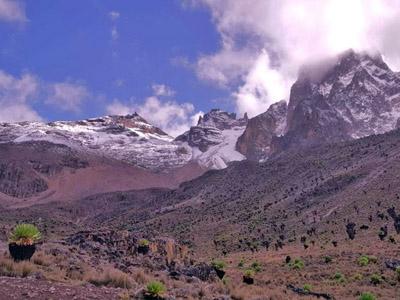
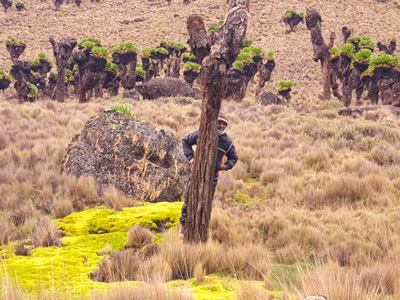
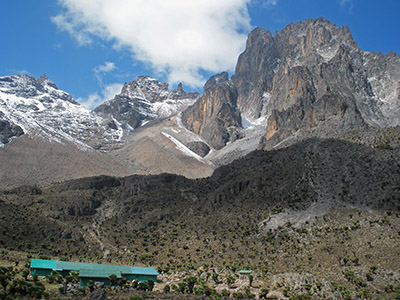
TRIP ITINERARY
01
Nairobi to Naru-moru
Leave Nairobi at 8:00 am to Naru-moru which normally takes 4hrs drive, arriving Nanyuki Anka Hotel at 12:00 o’clock time for lunch. After lunch you will be walking to the Mau Mau caves for the nature walk and for acclimatization, then return back to Anka Hotel. Dinner/overnight.
02
Naru-moru to Met Station
Hiking time: 3 hours
Habitat: Rain forest
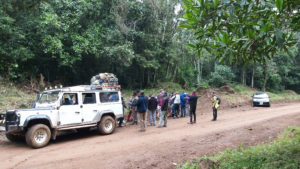
After breakfast proceed to Naru-moru gate which normally takes 45 minutes, you will have your picnic lunch at Naru-moru Gate and then start walking through rain forest for 3 hrs to Met Station 3,048m. Dinner/overnight.
03
Met Station (3,048m) to Mackinders Camp (4,350m)
Hiking time: 5-6 hours
Distance: About 14 km
Habitat: Bog and Moorland
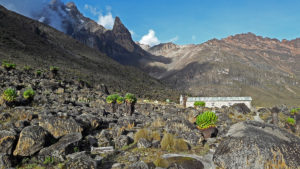
After breakfast your climb continue to Mackinders camp which is approximately 5-6 hrs,14km. You will walk through the vertical bog and tussock grass. At this point the main peaks provide a spectacular view of Batian and Nelion, continue walking through Teleki Valley. Dinner/overnight at Mackinders camp 4,350m.
04
Mackinders (4,350m) to Pt. Lenana (4,985m) down to Shipton’s Camp (4,250m)
Hiking time: 4 hours
Distance: 7 km
Habitat: Alpine desert
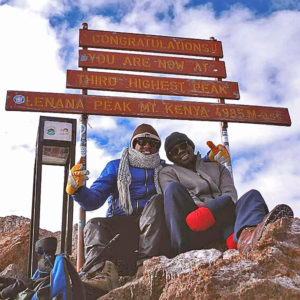
The ascension of the summit of Point Lenana begins before dawn at 3:00 o’clock to ensure time to view the sunrise from the peaks. The walk takes 3 hrs to Point Lenana 4,985m third highest peak. From here on the clear day, you can see Kilimanjaro. After the summit descend to Shiptons camp for breakfast. Dinner/overnight.
05
Shipton’s Camp (4,250m) to Old Moses Camp (3,300m)
Hiking time: 5 hours
Distance: 16 km
Habitat: Moorland
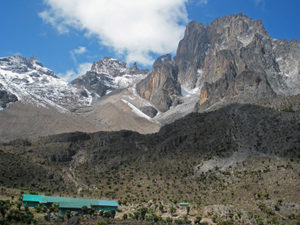
After breakfast continue walking down to Old Moses camp via Mackinders Valley. It will take 5 hours to reach the Moses camp 3,300m where you will have lunch and then meet up with your transport back to Nairobi.

- Fitness enables fun
- Hydrate excessively
- Polé-polé (ask if you don’t know!)
- Stop & Listen
TIPS & TRICKS
After leading many successful trips into the mountains there are several “trekking-hacks” we like to tell our clients to help them better enjoy their time in the mountains.
- Ski sticks are useful when ascending the scree to the summit.
- Ski sticks also help protect your knees when traveling downhill!
- Filling your bottle at night with hot water creates a comforting heating pad to slip in your bag or beneath your pillow
- Powdered drink mix / sports mix helps with maintaining hydration (Tang, Gatorade, Lemonade)
- Find a pace to your hiking that you could keep at all day.
- Remember to pack some of your favorite snacks for a break on the trail.
More Information
Accommodations:
Accommodations on the route is in roomy two person tents or in huts. The choice of lodging is part your preference and part availability.
The tents are usually erected for you when you arrive, although if you want a particular position it’s worth taking charge. In the mornings it helps everyone to get away early if you lend a hand with taking the tents down.
Huts on the other hand can be warmer however you there may be other trekking parties besides yours inside the shelter.
Acclimatization:
Acclimatization is extremely important, both to let you enjoy your ascent but more importantly to avoid any serious complications. The route is planned to optimize the height gain, but you may still get a headache or feel nauseous. There are two important preventative measures: to drink copiously, even when it is really difficult, and to walk very slowly, avoiding as much as possible increased heart and breathing rates.
A drug is available, Diamox, from your doctor which is well proven to help with acclimatization. This is taken as tablets for a few days before and then during your ascent. It is safe and has no serious side effects.
It is important to remember that one possible effect of altitude is light-headedness and odd behavior, which can lead to foolish decisions. The danger here is someone who is not well insisting on continuing. Watch each other closely.
Water & Washing:
Water is available at several points and should be purified before drinking. All water in camp will be boiled and some provided for drinking the next day. A comforting tip is to fill your bottle in the evening with boiled water for the next day, and to use it as a hot water bottle overnight. Check with your guide where the water points are.
Washrooms are available at the huts but not the camps. Some camps have several and so it’s worth checking for the cleanest. If you are caught short during the walk, please find a spot as far as possible from the trail and any water. Bury your feces and paper. It is often easiest to move a large rock and use the indent as a hole. Mark your spot by balancing a couple of stones.
Trekking Fitness:
Most hiking is strenuous, but not technical climbing, and no mountain-climbing experience is necessary. But there’s no avoiding the steep ascents and high altitudes that make robust physical fitness (and a minimum age of 11 years) a prerequisite for any trip. You’ll want to consult your physician before undertaking this unforgettable adventure.
Mountain Cuisine:
The menus for all climbs are specially prepared to provide a balanced diet of fresh fruit, vegetables, plenty of protein and carbohydrates. We have tried to choose food items that are easiest to digest at high altitude.
Dinners are typically a main course with vegetable and salad. Chicken and fish are served at some of the days during the climb, with pastas and rice dishes being served in the middle of the climb while up high.
Lunches are often on the trail and usually consist of cold cuts and vegetables laid out on a table so you can make your own sandwich. Fresh hot vegetable soups are served at every meal, and packet soup is available on request between meals as is coffee and tea.
Breakfast is your choice: granola, toast, fruit, eggs, and sometimes pancakes or French toast.
Kitchen Safety:
Food and kitchen equipment will be carried by the porters and cooked by an experienced cook. It will be plentiful and wholesome but may be limited by the circumstances. Our cooks undergo extensive training and we have ongoing workshops to review menus. The cooks are particularly vigilant in their hygiene practices as contracting stomach bugs is common for visitors to the developing world.
Your own supply of chocolate and high energy snacks is a recommended.
While hiking some people have a favorite food that they like; it is a good idea to bring this from home.









